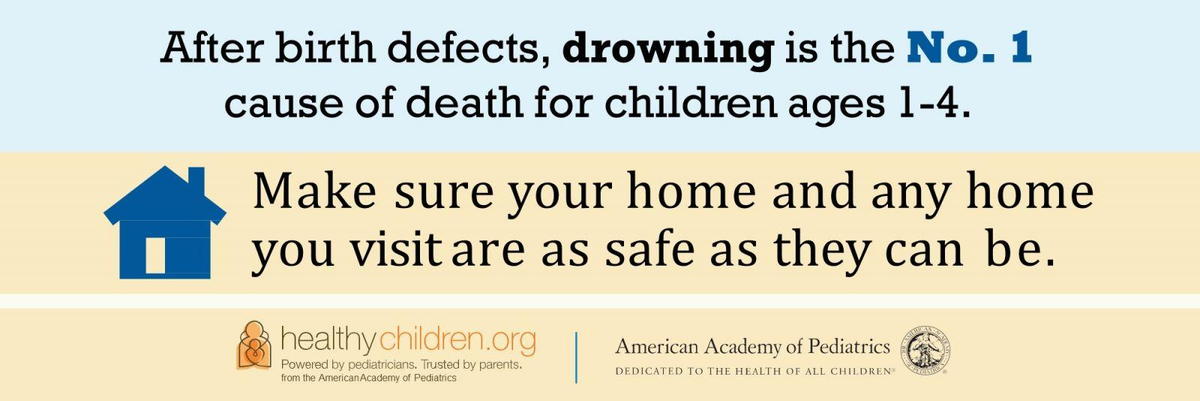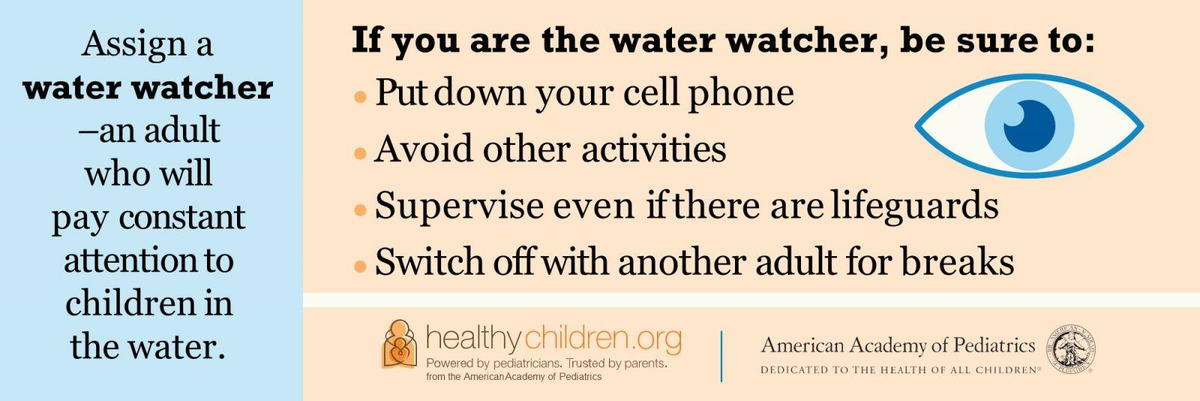Drowning is the leading injury-related cause of death for children age 1–4. It doesn’t only happen when you are by the pool or at the beach; drowning can happen anywhere, even in one inch of standing water. Among children under age 4, 70% of drownings happen during non-swim times. It is quick and it is silent, but it is preventable.
Memorial Day has come & gone, but summer is upon us and more families will be active around water. Join the American Academy of Pediatrics and be an advocate for Drowning Prevention. We all can reduce drowning and save children’s lives by working together to implement safety measures we know will protect children.
Drowning can happen to any family. It’s quick, and it’s silent. Drowning is the No. 1 cause of death among children aged 1-4, and is a leading cause of death among teens. We can lower these rates if pediatricians, parents and policy-makers work together to implement the types of solutions we know will keep children safe. Please share these resources with parents and caregivers.
An Important Message on Drowning from Grieving Parents:
Dear Doctors and Families,
We write this from a place of grief, a sense of urgency, and a hope that no other family experiences what we have this summer. On June 10, 2018, we each lost a child to drowning during a non-swim time: Emmy Miller (19 months) and Levi Hughes (3). In the midst of our grief, we are honored to be partnering with the American Academy of Pediatrics on a National Drowning Prevention Awareness Project. We respect our own pediatricians tremendously and hope this message conveys to you that high level of respect as we ask for your partnership with us on this endeavor.
Drowning is the #1 cause of preventable death between the ages 1-4 and the #2 cause in ages 5-14. Raising awareness of physicians, parents, and communities about this underrecognized killer is a shared responsibility that we must embrace. As health care providers, you are perfectly positioned to educate families about the importance of water safety and drowning prevention. We realize that well-child visits are busy, and there is much you must cover. However, you remain a deeply trusted source of information for parents. We hope our stories can help spur you to action and prevent future tragedies.
Over the last two months, we have been stunned to learn how often drownings occur during times when children are not swimming but slip away and drown in pools, ponds, streams, lakes, bathtubs, and even toilets. If you and your colleagues already share information on water safety, including drowning during non-swim times, we THANK YOU. If our stories inspire you to think about how you currently address water safety, we are grateful for your honest reflection.
We will be working with the AAP to develop resources to help you promote awareness using evidence-based approaches at multiple levels, from individual interactions to community and policy interventions. Pediatricians are, by nature, child advocates. If we can help elevate the prevention of drowning, it could save many lives. We believe in the power of the medical community, which is why we are reaching out to you.
Developing quality materials will take time, but we want to provide an action step that can be taken now, so we don’t lose valuable time in spreading awareness. We have developed a PDF flyer that we hope you will print out and hang in your clinics or include in your educational materials for families. Increasing parental awareness of the dangers of water can also lead to discussions of a “water safety plan” for all families. The development of these plans can be immediately implemented into well-child visits, without the need for any materials.
If you would like to know more about the stories of Emmy and Levi, here are the links to the TODAY Show interviews:
https://www.today.com/video/bode-and-morgan-miller-open-up-about-drowning-death-of-daughter-emmy-1288207939874
https://www.today.com/video/morgan-miller-fellow-mom-nicole-hughes-raise-awareness-after-drowning-of-children-1289047107813
We are incredibly grateful for your time and attention to this urgent matter.
With much respect,
The Hughes Family and the Miller Family





Swim Lessons: When to Start & What Parents Should Know
Infant Water Safety: Protect Your New Baby from Drowning
Drowning Prevention for Curious Toddlers: What Parents Need to Know
Beach, Boating, and Lake Swimming Safety Tips
Pool and Swimming Safety Tips
Parents and Caregivers: What You Should Know
-
Parents and caregivers should never (even for a moment) leave young children alone or in the care of another child while in or near bathtubs, pools, spas, or wading pools and when near irrigation ditches, ponds, or other open standing water.
-
Parents and caregivers must be aware of drowning risks associated with hazards in the home.
-
Infant bath seats can tip over, and children can slip out of them and drown in even a few inches of water in the bathtub. Infants should always be with an adult when sitting in a bath seat in a bathtub.
-
Water should be emptied from containers, such as pails and buckets, immediately after use.
-
To prevent drowning in toilets, young children should not be left alone in the bathroom, and toilet locks may be helpful.
-
Parents and caregivers should prevent unsupervised access to the bathroom, swimming pool, or open water.
-
-
Whenever infants and toddlers (or noncompetent swimmers) are in or around water, a supervising adult with swim skills should be within an arm’s length, providing constant touch supervision. Even with older children and better swimmers, the eyes and attention of the supervising adult should still be constantly focused on the child. This “water watcher” should not be engaged in other distracting activities that can compromise this attention, including using the telephone (eg, texting), socializing, tending chores, or drinking alcohol, and there needs to be a clear handoff of responsibility from one water watcher to the next. Supervision must be close, constant, and attentive. In case of an emergency, the supervising adult must be able to recognize a child in distress, safely perform a rescue, initiate CPR, and call for help. Parents need to recognize that lifeguards are only 1 layer of protection, and children in and near the water require constant caregiver supervision, even if a lifeguard is present.
-
To prevent unintended access, families should install a 4-ft, 4-sided isolation fence that separates the pool from the house and the rest of the yard with a self-closing, self-latching gate. Detailed guidelines for safety barriers for home pools are available online from the CPSC. Families of children with Autistic Spectrum Disorder or other disabilities who are at risk for wandering off should identify local hazards and work with the community on pool fencing and mitigation of hazards.
-
Although data are lacking, families may consider supplemental pool alarms and weight-bearing pool covers as additional layers of protection; however, neither alarms nor pool covers are a substitute for adequate fencing and adult supervision. Importantly, some types of pool covers, such as thin plastic solar covers, should not be used as a means of protection because they might increase risk of drowning.
-
Parents, caregivers, and pool owners should learn CPR and keep a telephone and rescue equipment approved by the US Coast Guard (eg, life buoys, life jackets, and a reach tool such as a shepherd’s crook) poolside. Older children and adolescents should learn CPR. See AAP.org. See American Red Cross.
-
Children and parents should learn to swim and learn water-safety skills. Because children develop at different rates, not all children will be ready to learn to swim at exactly the same age. There is evidence that swim lessons may reduce the risk of drowning, including for those 1 to 4 years of age. A parent’s decision about starting swim lessons or water-survival skills training at an early age must be individualized on the basis of the child’s frequency of exposure to water, emotional maturity, physical and cognitive limitations, and health concerns related to swimming pools. Parents should be reminded that swim lessons will not drown proof a child of any age. It is critical that swim instructors stress this message as well as the need for constant supervision around water. Swim ability must be considered as only 1 part of water competence and a multilayered protection plan that involves effective pool barriers; close, constant, and attentive supervision; life jacket use; training in CPR and the use of an automated external defibrillator; and lifeguards. Children need to be taught never to swim alone and never to swim without adult supervision.
-
Parents should monitor their child’s progress during swim lessons and continue their lessons at least until basic water competence is achieved. Basic swim skills include ability to enter the water, surface, turn around, propel oneself for at least 25 yards, float on or tread water, and exit the water.
-
Any time a young child visits a home or business where access to water exists (eg, pool, hot tub, open water), parents and/or guardians should carefully assess the premises to ensure that basic barriers are in place, such as sliding door locks and pool fences with closed gates in good working order, and ensure that supervision will be consistent with the preceding recommendations.
-
All children and adolescents should be required to wear US Coast Guard–approved life jackets whenever they are in or on watercraft, and all adults should wear life jackets when boating to model safe behavior and to facilitate their ability to help their child in case of emergency. Small children and nonswimmers should wear life jackets when they are near water and when swimming. Parents and caregivers should ensure that any life jacket is approved by the US Coast Guard because many do not meet safety requirements. Information about fitting and choosing US Coast Guard–approved life jackets is available at the US Coast Guard Web site. Parents should not use air-filled swimming aids (such as inflatable arm bands, neck rings, or “floaties”) in place of life jackets. These aids can deflate and are not designed to keep swimmers safe.
-
Jumping or diving into water can result in devastating spinal injury. Parents and children should know the depth of the water and the location of underwater hazards before jumping or diving or permitting children to jump or dive. The first entry into any body of water should be feet first.
-
When selecting an open body of water in which their children will swim, parents should select sites with lifeguards and designated areas for swimming. Even for the strongest of swimmers, it is important to consider weather, tides, waves, and water currents in selecting a safe location for recreational swimming. Swimmers should know what to do in case of rip currents: swim where there is a lifeguard, and if caught in a rip current, remain calm and either swim out of the rip current parallel to the shore (do not try to swim against the current) or tread water until safely out of the current and able to return to shore or signal for help.
-
Parents and children should recognize drowning risks in cold seasons. Children should refrain from walking, skating, or riding on weak or thawing ice on any body of water.
